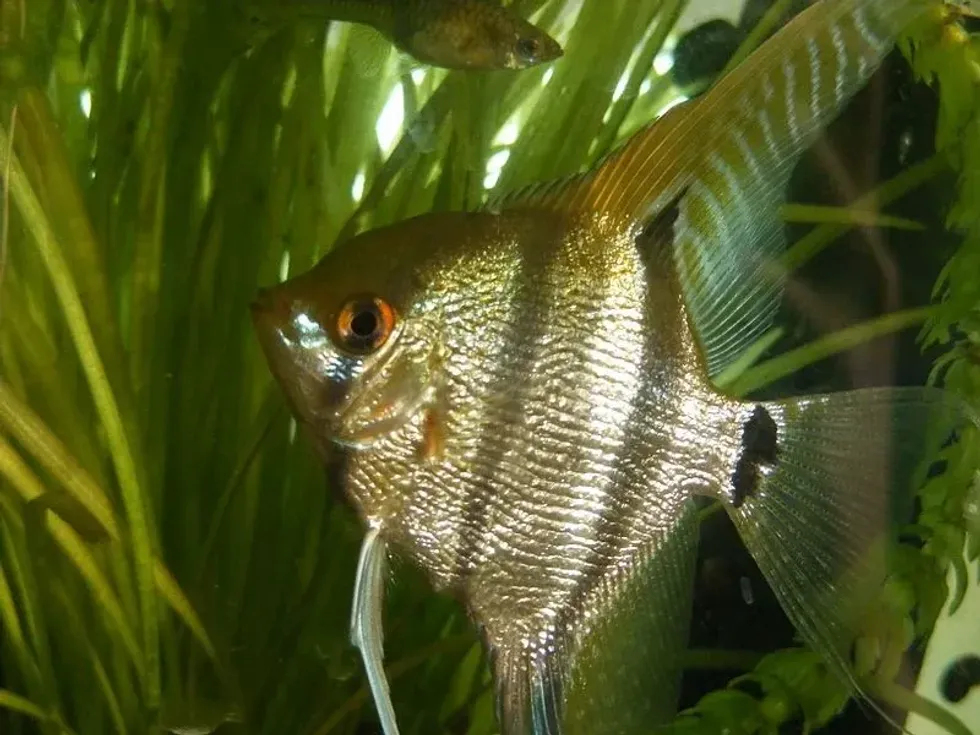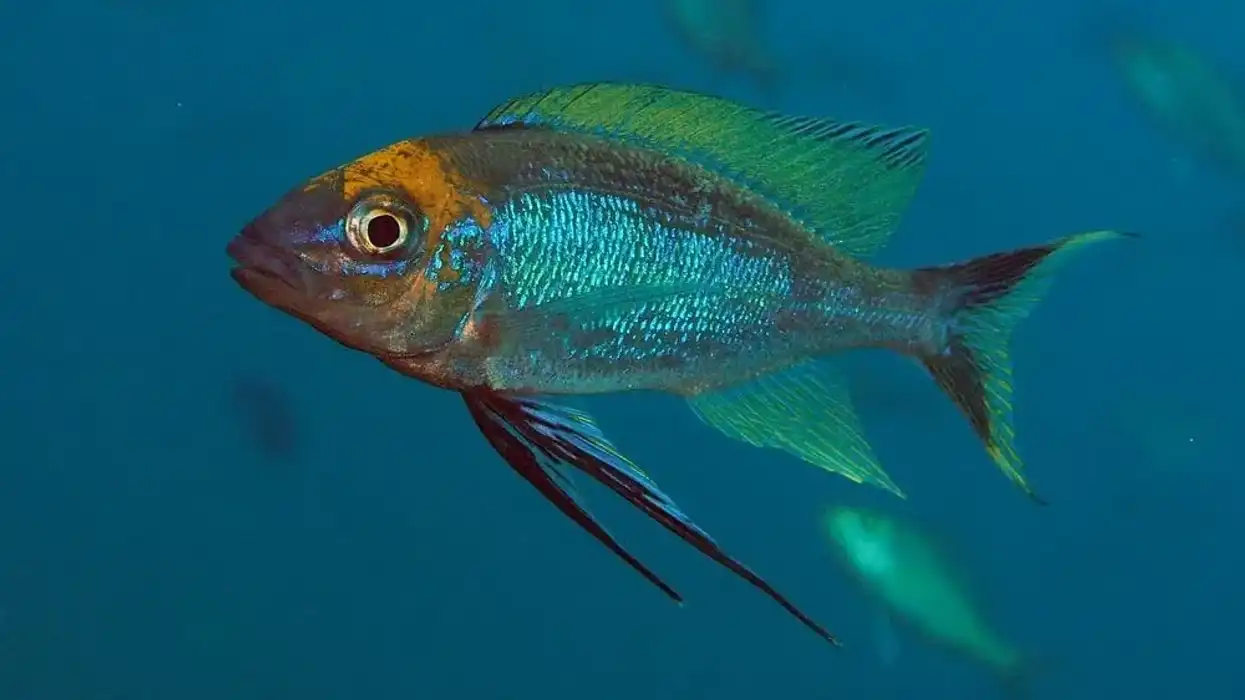The freshwater angelfish, Pterophyllum scalare, is one of the most commonly spotted fishes in aquariums and fish tanks. They are absolutely attractive, with shiny scales, striped bodies, long fins and bodies being just a few inches tall.
This Pterophyllum breed has a wide range, found in the shallow waters of tropical rivers and ocean reefs of the Amazon Basin in Brazil, Colombia and Peru. This fish got its common name back in the year 1824 by F. Schultze.
Brine shrimp, krills, smaller fishes, worms and other macroinvertebrates are listed as some of their favourite foods to eat. Though popular in the aquarium business, they demand specific water conditions to survive in the fish tanks.
For more relatable content, check out these black ghost facts and convict cichlid facts for kids.
Freshwater Angelfish Interesting Facts
What type of animal is a freshwater angelfish?
The freshwater angelfish is a type of angelfish.
What class of animal do a freshwater angelfish belong to?
The freshwater angelfish belongs to the class of fish.
How many freshwater angelfish are there in the world?
There is no exact estimate of the total population of this fish species.
Where does a freshwater angelfish live?
The freshwater angelfish can be spotted mainly in the waters of South America- around Colombia, French Guiana, Guyana, Peru, Brazil, and Suriname. Many river systems such as the main Amazon river drainage, Rio Ucayali, Rio Oyapock, and even Rio Essequibo are home to this fish.
What is a freshwater angelfish's habitat?
The angelfish prefer clean or silty waters, preferably a freshwater habitat. They are sensitive when it comes to poor water quality.
They prefer water temperatures within the range of 77-86 °F (25-30 °C). In their natural habitat, they are found in flooded ground and swamps with lush vegetation. Usually, they survive in water conditions having a pH range of 6.0-7.0 and the hardness of water being about 3-10 °dH.
Who do freshwater angelfish live with?
Freshwater angelfish either live alone or in small groups.
How long does a freshwater angelfish live?
The angelfish species is said to live for up to 30 long years.
How do they reproduce?
All the species under the Pterophyllum genus are known to form only monogamous pairs for breeding. The female angelfish lay between 200-400 eggs in each spawning.
The male angelfish would then fertilize these eggs externally with the help of his papilla. The eggs are laid systematically either under a flat leaf or on any submerged log in aquariums. In its natural marine habitat, the eggs are laid directly in the water, causing all the eggs to float up to the surface.
The parent fishes then look after the eggs and hatched fry for almost four weeks, before they let them be on their own. The fry hatch opens only after seven days of being laid.
What is their conservation status?
The conservation status of this freshwater fish is unknown.
Freshwater Angelfish Fun Facts
What does freshwater angelfish look like?
Compared to all cichlids, all the Pterophyllum species are slightly of a different shape. They are laterally compressed. Their bodies are round and they have large triangular anal and dorsal fins.
This helps them hide well among crevices and rocks , and even between aquatic vegetation. The freshwater angelfish is striped transversely. Their bodies are entirely silver, with four large black vertical stripes along.
Look at them carefully, and you can see their bodies looking like the heads of an arrow. They have triangular snouts. A juvenile angelfish has 7 black bands, but as they grow, it gets reduced to only four. Their scales sparkle from a distance, making it look absolutely spectacular.
It is said that the adult angelfish has about 35-45 scales in each row on its body. There is a black stripe running through the eye as well. They have really small mouths.
How cute are they?
This Pterophyllum breed is absolutely cute and beautiful!
How do they communicate?
The social status of the angelfish is demonstrated with the release of urine and bile in the water. These secretions contain chemical signals used for communication. Their bright and shiny bodies also help them in camouflaging well with the aquatic habitat and aids in communication.
How big is a freshwater angelfish?
The freshwater angelfish size is said to have a body length of about 6 in (15.24 cm), and their fins can grow to a length of 8 in (20.32 cm).
Their body length is equal to 4 times as that of the neon tetra.
How fast can a freshwater angelfish swim?
We are unaware of the exact speed with which the angelfish can swim. However, we know that this fish is actually not quite fast in swimming. Its small body is unable to withstand extreme strong currents, and hence it is always advised to maintain less water current if placing it in an aquarium.
How much does a freshwater angelfish weigh?
We are actually unaware of how much this member of the cichlid clan weighs. However, certain angelfish species can weigh up to 2 lb (0.91 kg).
What are the male and female names of the species?
There are no separate names for the male and female fishes of this cichlid species.
What would you call a baby freshwater angelfish?
Baby fishes are generally called 'fry'.
What do they eat?
The angelfish is actually a smart predatory species; it uses ambush techniques and attacks smaller fish as well as macroinvertebrates. Common diet ingredients include worms, crustaceans, larvae, rotifers, insects, and prawns as well.
The worms in their diet such as bloodworms, tubifex worms, vermicompost worms and many other types. Mosquito larvae and tubifex diet is highly nutritious to the angelfish.
The diet of live foods aids in an improved performance in the angel fish's reproductive activities. This angel breed is known to be omnivorous in their feeding habits. Brine shrimp, krill, frozen glass worms and water fleas are also consumed by the angelfish.
While kept in aquariums, the main diet of the angelfish is limited to protein rich pellets and flakes. For small bodies, they actually require to be fed at least two times in a day.
The angelfish, which is involved in breeding needs to be fed at least four times every 24 hours. It is sometimes advised to supplement the fish diet with cooked vegetables as well to provide fiber.
Are they aggressive?
You would be surprised to know that this little tropical fish actually displays aggressive behavior! During the breeding season, this fish is said to be extremely aggressive against the other fishes.
The male angels fight with each other over the right to mate. The female angels are extremely protective of their little offspring from other predators who are looking for something to food.
It is very rare you will spot them alone, and they always lurk in the waters in defensive pairs with their mates, or in large schools.
Would they make a good pet?
We love the idea of keeping these fishes in the aquarium!
However, proper care must be taken in looking after these cichlids' family members. Angelfish are prone to a parasitic condition called ‘ich’. This is usually caused by improper diet, unsafe food, overcrowding in the aquariums, or even poor water conditions. This condition might cause them to die as well.
Did you know...
The word Pterophyllum comes from the Greek terms ‘Pteron’ and ‘Phyllon’. The term ‘Pteron’ translates to ‘sail’ or ‘fin’, while ‘Phyllon’ translates to ‘leaf’.
Unfortunately, the angelfish falls prey to large birds such as shags, cormorants, kingfishers, dippers. Sharks, whales, and other larger fishes also gobble down angelfish. Even marine mammals include the angelfish in their diet.
The Altum Angelfish is the largest freshwater angelfish known, growing to a length of about 20 in (50.8 cm), measured from the dorsal fin tip to the anal fin tip.
Different types of angelfish
Albino angelfish: a completely white body with bright red eyes glowing in the aquarium, the fishes of this species are selectively bred and cannot be found in any natural marine areas. They are intelligent ambush predators, gobbling down all small fishes. They move slowly and are comfortable with frozen as well as live food.
Zebra angelfish: this little angel can grow to a length of 10 in (25.4 cm). They have white bodies with multiple black stripes. You can keep six or more of these in your aquarium.
Leopard angelfish: This species sport beautiful pale blue/white bodies with random black spots, patterned similar to a leopard. They are found abundantly in the Amazon river. High maintenance care is required for these angels, because if any parameter is not ideal, their body hue begins fading.
Marble angelfish: these angels have black, white and/or yellow marbled texture on their bodies. They prefer slightly warm and acidic waters. The aquarium must be of at least 30 US gallons (113.562 l) capacity if you are planning to keep five or more freshwater angelfish tank mates.
Altum angelfish: The altum is slightly demanding when it comes to its aquarium conditions. Water temperatures and the pH levels for the altum are crucial, else they would not survive.
Silver angelfish: This is one of the most popular angelfish breeds. It is quite similar to the altum. Usually, there are three black stripes on its silver body.
Black veil angelfish: the fish of this breed look like a thin sheer veil, and is a product of about 40 long years of precisive selective breeding! Also, this freshwater angelfish tank size must be of at least 30 US gallons (113.562 l) capacity, even if it is just for a pair of these angels!
Gold angelfish: another veil one, but with a golden twist for you!
Black lace angelfish: this one has a laid back behavior and doesn’t actively enjoy swimming. If you take good care of them, they would grow over 6 in (15.3 cm) in diameter, and about 14 in (35.5 cm) tall!
Blushing angelfish: this species has a pale body, but bright red/pink coloration near their cheeks, giving an appearance of blushing.
Koi angelfish: the koi species is a spinoff of the gold and the blushing angelfishes. It has got a white body, and traces of golden around its head, just like the koi fish. They can have a body length of about six in (15.3 cm) .
Smokey angelfish: not as vibrant or colorful as the other angel, this surely does have stunning asymmetrical patterns which might catch your eye. As the smokey species get old, their body develops even darker pigmentation.
How many angelfish should be kept together?
Maintaining this fish species can be a little complicated - it is always recommended to keep only one fish initially. You can gradually move on to two fishes of this species.
You can slowly move on to keeping 5-6 fishes in your tank, but maintenance would keep getting difficult, and hence smaller numbers are recommender. Getting a rare freshwater angelfish might be difficult, so keep an eye out for them! And do not forget to decorate it with tiny plants and rocks!
For more relatable content, check out these North Atlantic right whale facts and white tuna facts pages.
You can even enjoy at home by coloring in one of our free printable Freshwater angelfish coloring pages.









